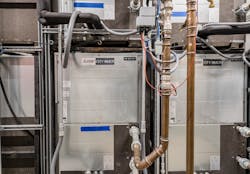Water-Source VRF System Sets New Efficiency Benchmarks
SUWANEE, GA – The Credit Human Federal Credit Union headquarters, San Antonio, Texas, sets a new standard for sustainable building design. A collaboration between Mitsubishi Electric Trane HVAC US LLC (METUS), a leading supplier of Ductless and Ducted Mini-split and Variable Refrigerant Flow (VRF) heat-pump and air-conditioning systems, and Credit Human, the building achieves ambitious goals for reduced energy consumption, water conservation and lowered carbon emissions.
Established in 1935 during the Great Depression, then under a different name, Credit Human was one of San Antonio’s first credit unions. The credit union’s customer base has since expanded far beyond the city limits now serving approximately 250,000 members in 43 states today. The business had clearly outgrown its old, 100,000-square-foot office space.
In keeping with Credit Human’s core values, Hennigan aimed to demonstrate how good stewardship of financial and environmental resources goes hand in hand. The Credit Human project team and METUS worked together to design a Mitsubishi Electric CITY MULTI® water-source VRF system with approximately 900 tons of capacity, supported by 152 ground-linked wells, to heat and cool the new headquarters.
Water is a Big Deal
All-electric VRF heat-pump and heat-recovery systems from METUS provide energy-efficient, high-performance heating and air conditioning to commercial spaces of all sizes and functions, including Credit Human. The zoning technology has earned the attention of environmental stewards and business leaders by delivering value and helping improve operating costs while maximizing sustainability and occupant comfort.
“We were thrilled to work with Credit Human on this project,” says Kimberly Llewellyn, senior project manager of emerging markets, Mitsubishi Electric Trane HVAC US LLC. “This was an excellent opportunity to demonstrate how our VRF solutions can be customized and deliver incredible modern and efficient heating and cooling.”
Efficiency Makes Business Sense
“Every new construction building brought into existence is going to be operating and probably not renovated for another thirty, forty or fifty years,” said Llewellyn. “Think about what we want from our next generation of buildings. We want energy-efficient, comfortable, and healthy buildings that are less susceptible to unforeseen weather events, changes in energy prices or water supply issues because they use less of these resources. These resilient buildings will be best positioned to thrive in the future.”
As builders and building owners realize the benefits of Mitsubishi Electric VRF technology, including sustainability, durability, efficiency, comfort control, improved IAQ and reduced lifecycle costs, expect more projects to follow Credit Human’s lead.
“I just thought this was an amazing project,” said Hennigan in closing. “This team was amazing, the vision was amazing, as were all of the people coming together to work on this… the results of what we’ve created are amazing, and we get to live here.”
To learn more about the Credit Human headquarters visit the Case Study page on MitsubishiComfort.com.



